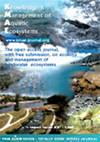马提尼克岛红爪小龙虾的入侵与分布
IF 1.7
3区 环境科学与生态学
Q3 FISHERIES
引用次数: 6
摘要
2004年,红爪小龙虾Cherax quadricarinatus被引入马提尼克岛用于水产养殖目的,试图振兴淡水甲壳类水产养殖部门。2015年,在对鱼类多样性的电钓调查中,发现了三个野生种群。2018年,在整个岛屿的34个地点使用聚光灯和诱饵陷阱在夜间进行了一项特定的小龙虾调查。主要分布于岛中部和北部,在8条河流和5个封闭水体中共捕获105只。我们对COI基因的491碱基对片段进行了测序,以了解来自Mangatal孵化场推定源群体的入侵历史和途径。8个单倍型中,3个为优势型,其中2个发生在Mangatal孵化场。由于小龙虾是活卖的,因此在整个岛屿的水文盆地中,人类介导的进一步引入的风险很高。因此,该物种的分布可能在整个马提尼克淡水生态系统中迅速扩大,对当地社区的生态影响尚未确定,需要紧急调查。本文章由计算机程序翻译,如有差异,请以英文原文为准。
Invasion and distribution of the redclaw crayfish, Cherax quadricarinatus, in Martinique
The redclaw crayfish, Cherax quadricarinatus, was introduced to Martinique Island for aquaculture purposes in 2004, in an attempt to revitalize the freshwater crustacean aquaculture sector. In 2015, three wild populations were discovered during an electrofishing survey on fish diversity. In 2018, a specific crayfish survey was performed at night using spotlighting and baited traps at 34 sites throughout the island. The species was mostly found in the center and northern part of the island, specifically, a total of 105 specimens were captured in eight streams and five closed water bodies. We sequenced a 491 base-pair fragment of the COI gene to understand the invasion history and pathway from the presumed source population at the Mangatal hatchery. Among the eight haplotypes found, three were dominant, of which, two occurred in the Mangatal hatchery. As crayfish are sold alive, there is a high risk of further human-mediated introductions across the island hydrographic basins. Thus, the distribution of this species could rapidly expand throughout Martinique freshwater ecosystems, with ecological impacts on native communities yet to be determined and requiring urgent investigation.
求助全文
通过发布文献求助,成功后即可免费获取论文全文。
去求助
来源期刊

Knowledge and Management of Aquatic Ecosystems
环境科学-海洋与淡水生物学
CiteScore
3.70
自引率
5.60%
发文量
22
审稿时长
>12 weeks
期刊介绍:
Knowledge and Management of Aquatic Ecosystems (KMAE-Bulletin Français de la Pêche et de la Pisciculture since 1928) serves as a foundation for scientific advice across the broad spectrum of management and conservation issues related to freshwater ecosystems.
The journal publishes articles, short communications, reviews, comments and replies that contribute to a scientific understanding of freshwater ecosystems and the impact of human activities upon these systems. Its scope includes economic, social, and public administration studies, in so far as they are directly concerned with the management of freshwater ecosystems (e.g. European Water Framework Directive, USA Clean Water Act, Canadian Water Quality Guidelines, …) and prove of general interest to freshwater specialists. Papers on insular freshwater ecosystems and on transitional waters are welcome. KMAE is not a preferred journal for taxonomical, physiological, biological, toxicological studies, unless a clear link to ecological aspects can be established. Articles with a very descriptive content can be accepted if they are part of a broader ecological context.
 求助内容:
求助内容: 应助结果提醒方式:
应助结果提醒方式:


